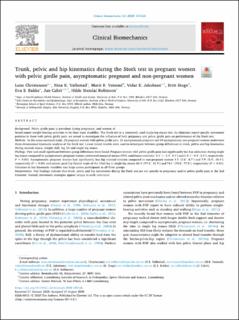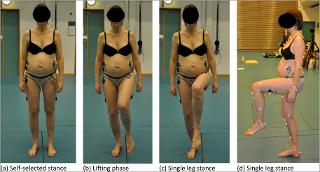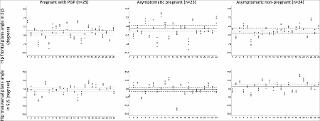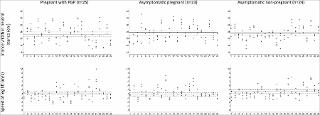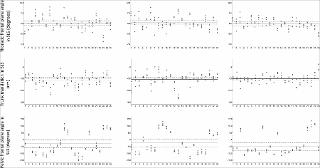| dc.contributor.author | Christensen, Lene | |
| dc.contributor.author | Vøllestad, Nina Køpke | |
| dc.contributor.author | Veierød, Marit Bragelien | |
| dc.contributor.author | Jakobsen, Vidar Eivind | |
| dc.contributor.author | Stuge, Britt | |
| dc.contributor.author | Bakke, Eva | |
| dc.contributor.author | Cabri, Jan Maria Hendrick | |
| dc.contributor.author | Robinson, Hilde Stendal | |
| dc.date.accessioned | 2021-03-19T23:01:32Z | |
| dc.date.available | 2021-03-19T23:01:32Z | |
| dc.date.created | 2021-02-02T10:08:59Z | |
| dc.date.issued | 2020 | |
| dc.identifier.citation | Clinical Biomechanics. 2020, 80, Artikkel 105168. | en_US |
| dc.identifier.issn | 0268-0033 | |
| dc.identifier.uri | https://hdl.handle.net/11250/2734577 | |
| dc.description | This is an open access article under the CC BY license (http://creativecommons.org/licenses/by/4.0/). | en_US |
| dc.description.abstract | Background: Pelvic girdle pain is prevalent during pregnancy, and women affected report weight-bearing activities to be their main disability. The Stork test is a commonly used single-leg-stance test. As clinicians report specific movement patterns in those with pelvic girdle pain, we aimed to investigate the influence of both pregnancy and pelvic girdle pain on performance of the Stork test.
Methods: In this cross-sectional study, 25 pregnant women with pelvic girdle pain, 23 asymptomatic pregnant and 24 asymptomatic non-pregnant women underwent three-dimensional kinematic analysis of the Stork test. Linear mixed models were used to investigate between-group differences in trunk, pelvic and hip kinematics during neutral stance, weight shift, leg lift and single leg stance.
Findings: Few and small significant between-group differences were found. Pregnant women with pelvic girdle pain had significantly less hip adduction during single leg stance compared to asymptomatic pregnant women (estimated marginal means (95% confidence intervals) -1.1° (−2.4°, 0.3°) and 1.0° (−0.4°, 2.4°), respectively; P = 0.03). Asymptomatic pregnant women had significantly less hip internal rotation compared to non-pregnant women 4.1° (1.6°, 6.7°) and 7.9° (5.4°, 10.4°), respectively (P = 0.04) and greater peak hip flexion angle of the lifted leg in single leg stance 80.4° (77.0°, 83.9°) and 74.1° (70.8°, 77.5°), respectively (P = 0.01). Variation in key kinematic variables was large across participants in all three groups.
Interpretation: Our findings indicate that trunk, pelvic and hip movements during the Stork test are not specific to pregnancy and/or pelvic girdle pain in the 2nd trimester. Instead, movement strategies appear unique to each individual. | en_US |
| dc.language.iso | eng | en_US |
| dc.subject | pelvic girdle pain | en_US |
| dc.subject | pregnancy | en_US |
| dc.subject | kinematics | en_US |
| dc.subject | asymptomatic pregnant | en_US |
| dc.subject | non-pregnant | en_US |
| dc.subject | hip movements | en_US |
| dc.subject | trunk movements | en_US |
| dc.subject | pelvic movements | en_US |
| dc.subject | Stork test | en_US |
| dc.subject | Gillet test | en_US |
| dc.title | Trunk, pelvic and hip kinematics during the Stork test in pregnant women with pelvic girdle pain, asymptomatic pregnant and non-pregnant women | en_US |
| dc.type | Peer reviewed | en_US |
| dc.type | Journal article | en_US |
| dc.description.version | publishedVersion | en_US |
| dc.rights.holder | © 2020 The Authors | en_US |
| dc.source.pagenumber | 8 | en_US |
| dc.source.volume | 80 | en_US |
| dc.source.journal | Clinical Biomechanics | en_US |
| dc.identifier.doi | 10.1016/j.clinbiomech.2020.105168 | |
| dc.identifier.cristin | 1885719 | |
| dc.description.localcode | Institutt for fysisk prestasjonsevne / Department of Physical Performance | en_US |
| dc.source.articlenumber | 105168 | en_US |
| cristin.ispublished | true | |
| cristin.fulltext | original | |
| cristin.qualitycode | 1 | |
